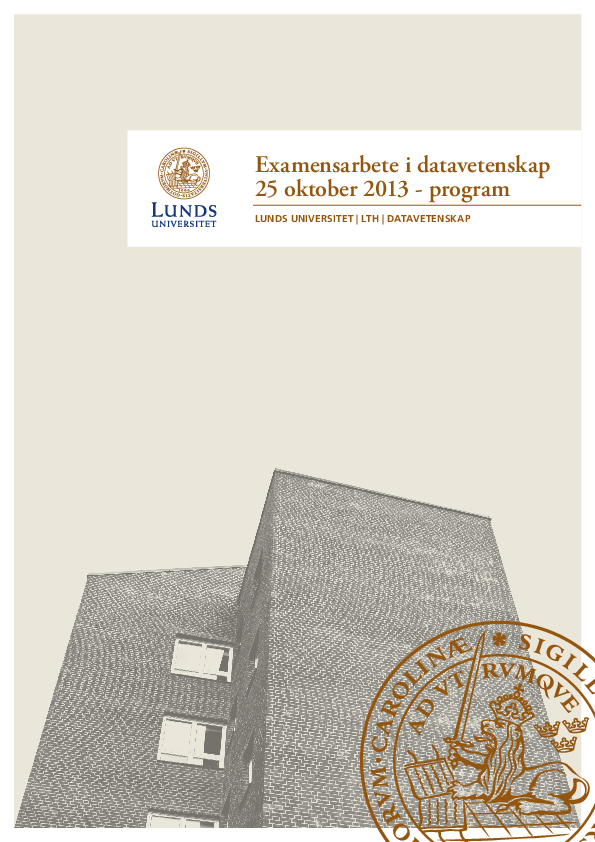Nyhetsvisning
1382652000
 January 17th is the day for the second coordinated master thesis presentations in Computer Science at Lund University, Faculty of engineering. The plan is to arrange these kinds of presentations 4-5 times a year. The event is open to all interested in listening to one or several seminars, as desired.
October 25 was the premiere of coordinated master thesis presentations in Computer Science at Lund University, Faculty of engineering. The plan is to arrange these kinds of presentations 4-5 times a year. The event is open to all interested in listening to one or several seminars, as desired.
January 17th is the day for the second coordinated master thesis presentations in Computer Science at Lund University, Faculty of engineering. The plan is to arrange these kinds of presentations 4-5 times a year. The event is open to all interested in listening to one or several seminars, as desired.
October 25 was the premiere of coordinated master thesis presentations in Computer Science at Lund University, Faculty of engineering. The plan is to arrange these kinds of presentations 4-5 times a year. The event is open to all interested in listening to one or several seminars, as desired.
When: Friday October 25 at 9-12 Where:
E:1406, E-huset, Ole Römers väg 3, Lund University
- Vahagn Baghomian: Body Monitoring Application Development Using Incremental Development and User-Centered Design
- Marcus Klang: Nedforia: A Tool for Named Entity Disambiguation
- Erik Westenius: Camera Based Gesture Detection in Android Devices
kl 09.15: Body monitoring application developed using incremental development and user-centred design
Författare/Author: Vahagn BaghomianHandledare/Supervisor:
Kirsten Rassmus-Gröhn (Certec, LTH)
Examinator/Examiner:
Martin Höst, LTH
Abstract:
Physically active people such as athletes require more nutrition than passive people. If such individuals are also heavily mentally active due to for example studying and exam preparations, they may neglect or not feel the sensation of hunger and so go hungry for long periods of time. This in turn has negative effects on their physical performance and may cause muscle deterioration.
This thesis addressed this issue by developing a smart-phone application that in combination with a heart-rate sensor and based on the daily activities and individual body attributes of a person, estimates the ideal time to eat. Furthermore it provides second-by-second heart-rate and energy expenditure information, both graphical and textual, and functionalities for comparing heart rate graphs directly in the phone, a feature not available in other sports-related applications.
The application was developed using incremental development strategy and user-centred design pattern, and in close cooperation with real-life users.
kl 10.15: Nedforia: A tool for Named Entity Disambiguation
Författare/Author: Marcus KlangHandledare/Supervisor:
Peter Exner, LTH
Examinator/Examiner:
Pierre Nugues, LTH
Abstract:
Named entity disambiguation is about the automatic identification of a real-world reference to a given string. Existing work on the subject have primarily targeted English and there exists very little dedicated research for Swedish.
In this thesis, I report the design and implementation of Nedforia, a named entity disambiguation tool for Swedish. Nedforia provides a full pipeline beginning with a dump of Wikipedia and ending with a disambiguator. Nedforia's core contribution consists of modules to parse wiki markup reliably, extract relevant pieces of information from Wikipedia, and manage large amounts of information. To evaluate the final disambiguation tool, I collected a test set created from 10 news articles where I hand-annotated and disambiguated the named entities. On this set, Nedforia could reach an F1-score of 66.49% using a Swedish Wikipedia dump from 2013-02-25. In addition to Swedish, Nedforia could easily be extended to support and manage multiple languages.
kl 11.15: Camera Based Gesture Detection on Android Devices
Författare/Author: Erik WesteniusHandledare/Supervisor:
Jim Rasmusson, Sony Mobile
Håkan Ardö, Matematik, LTH
Examinator/Examiner:
Klas Nilsson, Datavetenskap LTH
Abstract:
Most computer vision algorithms are to computationally expensive for use in smart phones. I therefor investigate the uses of so called ab- sdiff frames to develop a set of computationally cheap gesture detection algorithms. An absdiff frame is simply the absolute difference between two consecutive frames. I start by manipulating absdiff frames using morphology algorithms along with a border following algorithm to de- velop a gesture detection algorithm as well as a streamlined process for generating positive and negative classifier training sets. I later use this method for for training an open hand classifier for use on absdiff frames. I find that the greatest advantages of using a classifier based on absdiff frames is that it performs better in poor lighting conditions, it need less pictures in its training sets and it works on users with different ethnici- ties. A testing framework is developed using OpenCV and Android 4.0 - 4.2.
Källa:Exjob@cs
Sidansvarig: Jonas.Wisbrant@cs.lth.se | 2019-02-19
